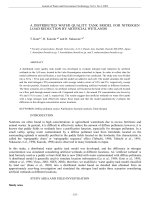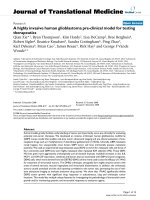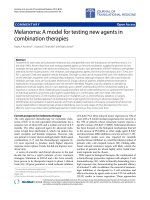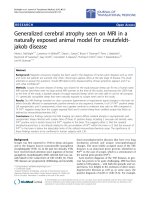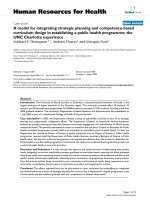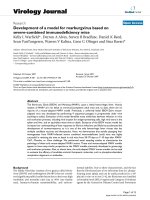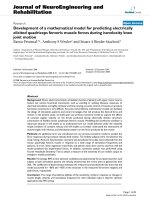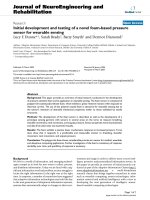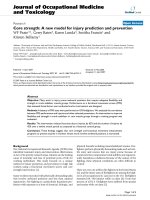A dynamic model for GPS based attitude determination and testing using a serial robotic manipulator
Bạn đang xem bản rút gọn của tài liệu. Xem và tải ngay bản đầy đủ của tài liệu tại đây (1.89 MB, 9 trang )
������������������������������������������������������������������������������������������������������������������������������������������������������������������������������������������������������������������������������������������������������������������������������������������������������������������������������������������������������������������������������������������������������������������������������������������������������������������������������������������������������������������������������������������������������������������������������������������������������������������������������������������������������������������������������������������������������������������������������������������������������������������������������������������������������������������������������������������������������������������������������������������������������������������������������������������������������������������������������������������������������������������������������������������������������������������������������������������������������������������������������������������������������������������������������������������������������������������������������������������������������������������������������������������������������������������������������������������������������������������������������������������������������������������������������������������������������������������������������������������������������������������������������������������������������������������������������������������������������������������������������������������������������������������������������������������������������������������������������������������������������������������������������������������������������������������������������������������������������������������������������������������������������������������������������������������������������������������������������������������������������������������������������������������������������������������������������������������������������������������������������������������������������������������������������������������������������������������������������������������������������������������������������������������������������������������������������������������������������������������������������������������������������������������������������������������������������������������������������������������������������������������������������������������������������������������������������������������������������������������������������������������������������������������������������������������������������������������������������������������������������������������������������������������������������������������������������������������������������������������������������������������������������������������������������������������������������������������������������������������������������������������������������������������������������������������������������������������������������������������������������������������������������������������������������������������������������������������������������������������������������������������������������������������������������������������������������������������������������������������������������������������������������������������������������������������������������������������������������������������������������������������������������������������������������������������������������������������������������������������������������������������������������������������������������������������������������������������������������������������������������������������������������������������������������������������������������������������������������������������������������������������������������������������������������������������������������������������������������������������������������������������������������������������������������������������������������������������������������������������������������������������������������������������������������������������������������������������������������������������������������������������������������������������������������������������������������������������������������������������������������������������������������������������������������������������������������������������������������������������������������������������������������������������������������������������������������������������������������������������������������������������������������������������������������������������������������������������������������������������������������������������������������������������������������������������������������������������������������������������������������������������������������������������������������������������������������������������������������������������������������������������������������������������������������������������������������������������������������������������������������������������������������������������������������������������������������������������������������������������������������������������������������������������������������������������������������������������������������������������������������������������������������������������������������������������������������������������������������������������������������������������������������������������������������������������������������������������������������������������������������������������������������������������������������������������������������������������������������������������������������������������������������������������������������������������������������������������������������������������������������������������������������������������������������������������������������������������������������������������������������������������������������������������������������������������������������������������������������������������������������������������������������������������������������������������������������������������������������������������������������������������������������������������������������������������������������������������������������������������������������������������������������������������������������������������������������������������������������������������������������������������������������������������������������������������������������������������������������������������������������������������������������������������������������������������������������������������������������������������������������������������������������������������������������������������������������������������������������������������������������������������������������������������������������������������������������������������������������������������������������������������������������������������������������������������������������������������������������������������������������������������������������������������������������������������������������������������������������������������������������������������������������������������������������������������������������������������������������������������������������������������������������������������������������������������������������������������������������������������������������������������������������������������������������������������������������������������������������������������������������������������������������������������������������������������������������������������������������������������������������������������������������������������������������������������������������������������������������������������������������������������������������������������������������������������������������������������������������������������������������������������������������������������������������������������������������������������������������������������������������������������������������������������������������������������������������������������������������������������������������������������������������������������������������������������������������������������������������������������������������������������������������������������������������������������������������������������������������������������������������������������������������������������������������������������������������������������������������������������������������������������������������������������������������������������������������������������������������������������������������������������������������������������������������������������������������������������������������������������������������������������������������������������������������������������������������������������������������������������������������������������������������������������������������������������������������������������������������������������������������������������������������������������������������������������������������������������������������������������������������������������������������������������������������������������������������������������������������������������������������������������������������������������������������������������������������������������������������������������������������������������������������������������������������������������������������������������������������������������������������������������������������������������������������������������������������������������������������������������������������������������������������������������������������������������������������������������������������������������������������������������������������������������������������������������������������������������������������������������������������������������������������������������������������������������������������������������������������������������������������������������������������������������������������������������������������������������������������������������������������������������������������������������������������������������������������������������������������������������������������������������������������������������������������������������������������������������������������������������������������������������������������������������������������������������������������������������������������������������������������������������������������������������������������������������������������������������������������������������������������������������������������������������������������������������������������������������������������������������������������������������������������������������������������������������������������������������������������������������������������������������������������������������������������������������������������������������������������������������������������������������������������������������������������������������������������������������������������������������������������������������������������������������������������������������������������������������������������������������������������������������������������������������������������������������������������������������������������������������������������������������������������������������������������������������������������������������������������������������������������������������������������������������������������������������������������������������������������������������������������������������������������������������������������������������������������������������������������������������������������������������������������������������������������������������������������������������������������������������������������������������������������������������������������������������������������������������������������������������������������������������������������������������������������������������������������������������������������������������������������������������������������������������������������������������������������������������������������������������������������������������������������������������������������������������������������������������������������������������������������������������������������������������������������������������������������������������������������������������������������������������������������������������������������������������������������������������������������������������������������������������������������������������������������������������������������������������������������������������������������������������������������������������������������������������������������������������������������������������������������������������������������������������������������������������������������������������������������������������������������������������������������������������������������������������������������������������������������������������������������������������������������������������������������������������������������������������������������������������������������������������������������������������������������������������������������������������������������������������������������������������������������������������������������������������������������������������������������������������������������������������������������������������������������������������������������������������������������������������������������������������������������������������������������������������������������������������������������������������������������������������������������������������������������������������������������������������������������������������������������������������������������������������������������������������������������������������������������������������������������������������������������������������������������������������������������������������������������������������������������������������������������������������������������������������������������������������������������������������������������������������������������������������������������������������������������������������������������������������������������������������������������������������������������������������������������������������������������������������������������������������������������������������������������������������������������������������������������������������������������������������������������������������������������������������������������������������������������������������������������������������������������������������������������������������������������������������������������������������������������������������������������������������������������������������������������������������������������������������������������������������������������������������������������������������������������������������������������������������������������������������������������������������������������������������������������������������������������������������������������������������������������������������������������������������������������������������������������������������������������������������������������������������������������������������������������������������������������������������������������������������������������������������������������������������������������������������������������������������������������������������������������������������������������������������������������������������������������������������������������������������������������������������������������������������������������������������������������������������������������������������������������������������������������������������������������������������������������������������������������������������������������������������������������������������������������������������������������������������������������������������������������������������������������������������������������������������������������������������������������������������������������������������������������������������������������������������������������������������������������������������������������������������������������������������������������������������������������������������������������������������������������������������������������������������������������������������������������������������������������������������������������������������������������������������������������������������������������������������������������������������������������������������������������������������������������������������������������������������������������������������������������������������������������������������������������������������������������������������������������������������������������������������������������������������������������������������������������������������������������������������������������������������������������������������������������������������������������������������������������������������������������������������������������������������������������������������������������������������������������������������������������������������������������������������������������������������������������������������������������������������������������������������������������������������������������������������������������������������������������������������������������������������������������������������������������������������������������������������������������������������������������������������������������������������������������������������������������������������������������������������������������������������������������������������������������������������������������������������������������������������������������������������������������������������������������������������������������������������������������������������������������������������������������������������������������������������������������������������������������������������������������������������������������������������������������������������������������������������������������������������������������������������������������������������������������������������������������������������������������������������������������������������������������������������������������������������������������������������������������������������������������������������������������������������������������������������������������������������������������������������������������������������������������������������������������������������������������������������������������������������������������������������������������������������������������������������������������������������������������������������������������������������������������������������������������������������������������������������������������������������������������������������������������������������������������������������������������������������������������������������������������������������������������������������������������������������������������������������������������������������������������������������������������������������������������������������������������������������������������������������������������������������������������������������������������������������������������������������������������������������������������������������������������������������������������������������������������������������������������������������������������������������������������������������������������������������������������������������������������������������������������������������������������������������������������������������������������������������������������������������������������������������������������������������������������������������������������������������������������������������������������������������������������������������������������������������������������������������������������������������������������������������������������������������������������������������������������������������������������������������������������������������������������������������������������������������������������������������������������������������������������������������������������������������������������������������������������������������������������������������������������������������������������������������������������������������������������������������������������������������������������������������������������������������������������������������������������������������������������������������������������������������������������������������������������������������������������������������������������������������������������������������������������������������������������������������������������������������������������������������������������������������������������������������������������������������������������������������������������������������������������������������������������������������������������������������������������������������������������������������������������������������������������������������������������������������������������������������������������������������������������������������������������������������������������������������������������������������������������������������������������������������������������������������������������������������������������������������������������������������������������������������������������������������������������������������������������������������������������������������������������������������������������������������������������������������������������������������������������������������������������������������������������������������������������������������������������������������������������������������������������������������������������������������������������������������������������������������������������������������������������������������������������������������������������������������������������������������������������������������������������������������������������������������������������������������������������������������������������������������������������������������������������������������������������������������������������������������������������������������������������������������������������������������������������������������������������������������������������������������������������������������������������������������������������������������������������������������������������������������������������������������������������������������������������������������������������������������������������������������������������������������������������������������������������������������������������������������������������������������������������������������������������������������������������������������������������������������������������������������������������������������������������������������������������������������������������������������������������������������������������������������������������������������������������������������������������������������������������������������������������������������������������������������������������������������������������������������������������������������������������������������������������������������������������������������������������������������������������������������������������������������������������������������������������������������������������������������������������������������������������������������������������������������������������������������������������������������������������������������������������������������������������������������������������������������������������������������������������������������������������������������������������������������������������������������������������������������������������������������������������������������������������������������������������������������������������������������������������������������������������������������������������������������������������������������������������������������������������������������������������������������������������������������������������������������������������������������������������������������������������������������������������������������������������������������������������������������������������������������������������������������������������������������������������������������������������������������������������������������������������������������������������������������������������������������������������������������������������������������������������������������������������������������������������������������������������������������������������������������������������������������������������������������������������������������������������������������������������������������������������������������������������������������������������������������������������������������������������������������������������������������������������������������������������������������������d beforehand on Movemaster EX Simulator as shown in Figs. 2–4. Just
before starting of these three dynamic tests, corresponding experiments in static modes were carried out to provide the initial attitude angles which were used in the verification analysis afterward.
Based on the simulation models described above, and the
dynamic experiments were conducted, such that the rotation of
antennas was controlled by the robotic arm. In this experiment,
the platform mounted with antennas rotated with a constant
angular rate. The GPS data was collected at 1 Hz sampling rate.
The LSAD and the EKF were used for static and dynamic modes
accordingly to calculate the yaw, roll and pitch angles. Integer
339
ambiguities were computed as a result of static experiments which
were used as input to the algorithm for dynamic attitude
determination.
The following parameters were used to tune the extended Kalman filter. The standard deviation of carrier phase noise was 2 mm.
The matrix R was calculated based on the satellite geometry and
the position of the master antenna at the starting epoch. The
yaw, roll, and pitch estimates were initialized using the LSAD
results at the first epoch. The initial angular rates were calculated
by averaging the between-epoch variations of yaw, roll, and pitch
angles during the entire static observation session.
Software design
A piece of software on MATLAB has been implemented to process the data from the mounted GPS antennas. This software is
used for post-processing of the RINEX data, which was obtained
by converting corresponding navigational files output by the GPS
receivers.
Attitude determination starts with the data synchronization.
The GPS measurements from all three antennas at the same receipt
epoch are processed to carry out the data synchronization. The
position of the master antenna should be calculated prior to performing the differential positioning. If there is no available ground
base station for differential correction, the position of the master
antenna can be computed by single-point positioning (SPP).
Although the related positioning accuracy can be around several
tens of meters with Selective Availability turned off, it will only
Fig. 6. Computation of yaw and pitch angles in static mode.
Fig. 7. Verification of yaw angle determination in dynamic mode.
340
A. Raskaliyev et al. / Journal of Advanced Research 8 (2017) 333–341
Fig. 8. Verification of pitch angle determination in dynamic mode.
affect the positioning accuracy of slave antennas at millimeter
level. It implies that the accuracy of the attitude parameters will
not be significantly degraded due to the application of SPP to the
master antenna.
Having known the position of the master antenna, the differential positioning can be performed in order to derive the baseline
vectors between antennas by making use of the LSAD method.
For this purpose, the integer phase ambiguities should be resolved
first by employing the baseline constrained LAMBDA method. In
order to obtain initial values as the input of the LSAD method,
the Euler angles can be firstly computed by employing the direct
attitude computation method.
In order to apply the extended Kalman filter, the antenna body
frame (ABF) should be fixed at first. With two or three antennas,
the ABF can be determined based on the simple geometric formulas, whereby the length of each master-slave antenna pair should
be accurately measured. Note that the ABF needs to be fixed only
one time before the rotation along any orientation angle starts.
The flowchart for the data processing in a GPS-based attitude
determination system is illustrated below (see Fig. 5).
Experimental results
Good results were obtained at the first stage (static mode) in
the computation of yaw and pitch angles, as shown in Fig. 6. Note
that instead of extended Kalman filter, Least Squares Adjustment
method was used for this case because it was not possible to utilize
the dynamic model.
Fig. 7 presents the difference in dynamic mode between yaw
angles calculated by the developed software and the corresponding
verification model. The model benefited a lot from the nearly constant angular rate of the platform’s rotation.
Fig. 8 shows a comparison between pitch angles computed by
extended Kalman filter implemented in the algorithm and the verification model for the dynamic mode. An increased error in attitude determination for this case might be caused by slight
bending of the antenna platform during the pitch dynamic test.
Unfortunately, demonstrative results from the roll angle
dynamic experiments were not acquired due to multiple data gaps
in GPS readings from two antennas. These data interruptions took
place because of carrier phase cycle slips caused by the particular
rotation plane of the platform that partially prevented a line of
sight with navigational satellites.
Conclusions
This paper has presented a way to resolve 3-axis attitude using
three inexpensive single frequency GPS antennas, despite a
dynamic environment and a low measurement sampling rate in
signal reception which is 1 Hz. The 3-axis attitude estimation algorithm solves a mixed real/integer problem by taking advantage of
given useful information such as baseline lengths and preliminary
construction of the dynamic model. The efficiency of this paper’s
algorithm is demonstrated by application to a set of data from a
serial robotic arm experiment with mostly rotational motion.
Despite some signal gaps, the raw GPS data is successfully processed by implementing baseline constrained LAMBDA method
to produce accurate double differences of carrier phases and baseline vectors. These baseline vectors are input to the extended Kalman filter based on the constant angular rate model that solves for
the real-valued attitude solution simultaneously. The results were
reasonable when compared with those from a verification model
constructed based on preliminarily assigned movements of the
manipulator’s end effector, although there still looks to be some
sort of time tagging or coordinate frame definition error.
The goal of this work was to develop GPS-based attitude determination algorithm based on the predefined dynamic model. The
performance of this technique was tested in a series of experiments by using a serial robotic arm. Finally, the success rate and
accuracy of this algorithm can be improved by incorporating
appropriate cycle slip repair method for post-processing of the
occurred data gaps.
Conflict of interest
The authors have declared no conflict of interest.
Compliance with Ethics Requirments
This article does not contain any studies with human or animal
subjects.
References
[1] Gong A, Zhao X, Pang C, Duan R, Wang Y. GNSS single frequency, single epoch
reliable attitude determination method with baseline vector constraint.
Passaro VMN ed Sensor (Basel Switzerland) 2015;15(12):30093–103.
A. Raskaliyev et al. / Journal of Advanced Research 8 (2017) 333–341
[2] Park C, Teunissen PJG. Integer least squares with quadratic equality constraints
and its application to GNSS attitude determination systems. Int J Control
Autom Syst 2009;7:566–76.
[3] Teunissen PJG. Integer least-squares theory for the GNSS compass. J Geod
2010;84:433–47.
[4] Baroni L, Kuga HK. Analysis of attitude determination methods using GPS
carrier phase measurements. Math Probl Eng 2012.
[5] Teunissen PJG. The affine constrained GNSS attitude model and its multivariate
integer least-squares solution. J Geodesy 2012;86(7):547–63.
[6] Giorgi G, Teunissen PJ, Verhagen S, Buist PJ. Instantaneous ambiguity
resolution
in
Global-Navigation-Satellite-System-based
attitude
determination applications A multivariate constrained approach. J Guid
Contr Dyn 2012;35(1):51–67.
[7] Bing W, Lifen S, Guorui X, Yu D, Guobin Q. Comparison of attitude
determination approaches using multiple Global Positioning System (GPS)
antennas. Geodesy Geodyn 2013;4(1):16–22.
[8] Buist P. The baseline constrained LAMBDA method for single epoch. IONGNSS: Single Frequency Attitude Determination Applications; 2007.
341
[9] Teunissen P. The LAMBDA method for the GNSS compass. Artif Satell 2006;41
(3):89–103.
[10] Park C, Teunissen P. A new carrier phase ambiguity estimation for GNSS
attitude determination systems. In: Proceedings of international GPS/GNSS
symposium, Tokyo.
[11] Dai Z, Knedlik S, Loffeld O. A MATLAB toolbox for attitude determination with
GPS multi-antenna systems. GPS Solut 2009;13(3):241–8.
[12] Wertz JR. Spacecraft attitude determination and control: springer science &
business media; 2012.
[13] Lu G. Development of a GPS multi-antenna system for attitude determination.
Ph.D. thesis. Calgary: University of Calgary; 1995.
[14] Dai Z. On GPS based attitude determination. Ph.D. Dissertation. Siegen:
University of Siegen; 2013.
[15] Bar-Shalom Y, Li XR, Kirubarajan T. Estimation with applications to tracking
and navigation: theory algorithms and software. John Wiley & Sons; 2004.
[16] Simon D. Optimal state estimation: Kalman, H infinity, and nonlinear
approaches. John Wiley & Sons; 2006.
